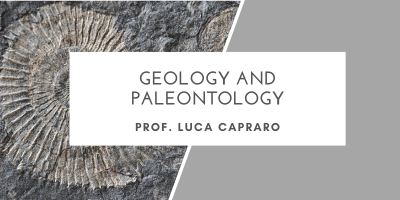Geology and Paleontology

Period: Annual
Course unit contents:
UNIT 1 (Paleontology)
1 – Introduction
What is Paleontology? Definition, history, modern applications. The Geologic Time. Evolution of Life: concepts, models, drawbacks; mass extinctions.
2 – Fossils and their origin
Fossilization processes.
3 – Systematics
Principles of classification and taxonomy; Basic information on the morphology, paleoecology, and chronological distribution of fossils belonging to key invertebrate groups such as sponges, corals, brachiopods, mollusks, echinoderms, trilobites.
4 – History of Life on Earth
Precambrian: from the origin of Life to the Huronian glaciation and multicellularity. The late Precambrian “strange life”: the Snowball Earth glaciation as an incubator for complex Life and the Early Cambrian explosion. Paleozoic: from the age of fish to the escape from the Ocean. The radiation of terrestrial vertebrates and plants. From the luxuriant Carboniferous forests to the Permian wastelands. The brutal end-Permian mass extinction. Mesozoic: the rise of dinosaurs and their fall at the K-Pg mass extinction. Cenozoic: mammals and angiosperms take over.
5 – Laboratories
Hands-on experience on fossilized specimens from the main invertebrate taxonomic groups described during the class. A 3-day trip in the field for geological and paleontological observations.
UNIT 2 (Geology)
1 – Introduction of sedimentary geology
sedimentary cycle, including weathering, erosion, transportation, deposition, burial, lithification; recognition of sedimentary structures; depositional environments.
2 – Stratigraphy
Principle of statigraphy and integrated stratigraphy (litho-, bio-, chrono-, magnetostratigraphy).
3 – Laboratories
Labs consist of exercises to learn describing and classifying sedimentary rocks; interpreting stratigraphic logs.
Planned learning activities and teaching methods: Teaching is based lectures, labs and field trip activities. Lectures include power point presentations, scientific articles and schemes.
Lab activities includes rocks and fossils in hand specimens, stratigraphic logs, geological maps
Observations and samples collected in the field trip will be then used in the lab activities.
The use of Artificial Intelligence tools is forbidden throughout the duration of the Course.
In addition to contacting the course instructor, students with disabilities, Specific Learning Disorders (SLD), Special Educational Needs (SEN), and other health conditions can reach out to the Student Services Office - Inclusion Unit to receive more information about opportunities to access teaching with specific support and tools.
